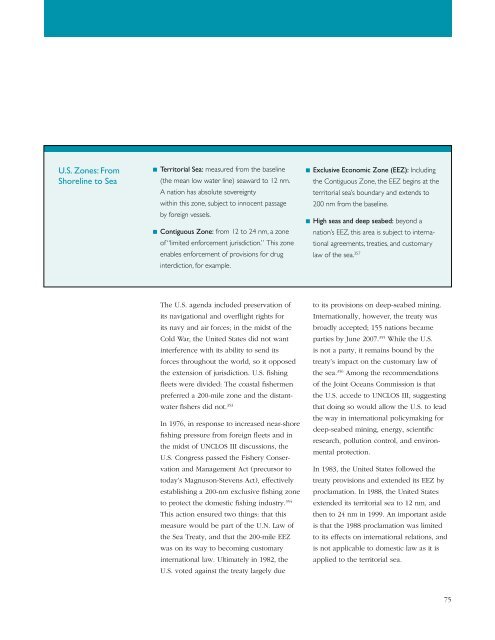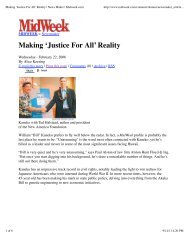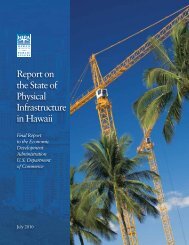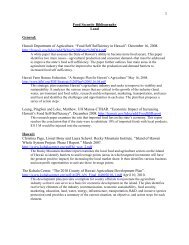Hawai'i Fisheries Initiative - The Hawaii Institute for Public Affairs
Hawai'i Fisheries Initiative - The Hawaii Institute for Public Affairs
Hawai'i Fisheries Initiative - The Hawaii Institute for Public Affairs
Create successful ePaper yourself
Turn your PDF publications into a flip-book with our unique Google optimized e-Paper software.
U.S. Zones: From<br />
Shoreline to Sea<br />
n Territorial Sea: measured from the baseline<br />
(the mean low water line) seaward to 12 nm.<br />
A nation has absolute sovereignty<br />
within this zone, subject to innocent passage<br />
by <strong>for</strong>eign vessels.<br />
n Contiguous Zone: from 12 to 24 nm, a zone<br />
of “limited en<strong>for</strong>cement jurisdiction.” This zone<br />
enables en<strong>for</strong>cement of provisions <strong>for</strong> drug<br />
interdiction, <strong>for</strong> example.<br />
n Exclusive Economic Zone (EEZ): Including<br />
the Contiguous Zone, the EEZ begins at the<br />
territorial sea’s boundary and extends to<br />
200 nm from the baseline.<br />
n High seas and deep seabed: beyond a<br />
nation’s EEZ, this area is subject to international<br />
agreements, treaties, and customary<br />
law of the sea. 357<br />
<strong>The</strong> U.S. agenda included preservation of<br />
its navigational and overflight rights <strong>for</strong><br />
its navy and air <strong>for</strong>ces; in the midst of the<br />
Cold War, the United States did not want<br />
interference with its ability to send its<br />
<strong>for</strong>ces throughout the world, so it opposed<br />
the extension of jurisdiction. U.S. fishing<br />
fleets were divided: <strong>The</strong> coastal fishermen<br />
preferred a 200-mile zone and the distantwater<br />
fishers did not. 353<br />
In 1976, in response to increased near-shore<br />
fishing pressure from <strong>for</strong>eign fleets and in<br />
the midst of UNCLOS III discussions, the<br />
U.S. Congress passed the Fishery Conservation<br />
and Management Act (precursor to<br />
today’s Magnuson-Stevens Act), effectively<br />
establishing a 200-nm exclusive fishing zone<br />
to protect the domestic fishing industry. 354<br />
This action ensured two things: that this<br />
measure would be part of the U.N. Law of<br />
the Sea Treaty, and that the 200-mile EEZ<br />
was on its way to becoming customary<br />
international law. Ultimately in 1982, the<br />
U.S. voted against the treaty largely due<br />
to its provisions on deep-seabed mining.<br />
Internationally, however, the treaty was<br />
broadly accepted; 155 nations became<br />
parties by June 2007. 355 While the U.S.<br />
is not a party, it remains bound by the<br />
treaty’s impact on the customary law of<br />
the sea. 356 Among the recommendations<br />
of the Joint Oceans Commission is that<br />
the U.S. accede to UNCLOS III, suggesting<br />
that doing so would allow the U.S. to lead<br />
the way in international policymaking <strong>for</strong><br />
deep-seabed mining, energy, scientific<br />
research, pollution control, and environmental<br />
protection.<br />
In 1983, the United States followed the<br />
treaty provisions and extended its EEZ by<br />
proclamation. In 1988, the United States<br />
extended its territorial sea to 12 nm, and<br />
then to 24 nm in 1999. An important aside<br />
is that the 1988 proclamation was limited<br />
to its effects on international relations, and<br />
is not applicable to domestic law as it is<br />
applied to the territorial sea.<br />
75







